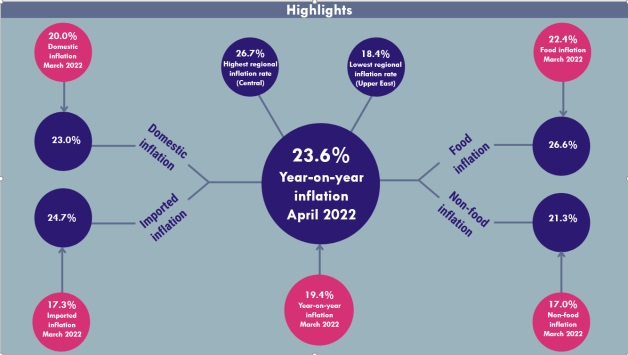The pass-through effect of the 15 percent increase in transport fares has taken a heavy toll on the general prices of goods and services, as inflation shot through the roof in April.
Data published by the Ghana Statistical Service (GSS) have shown that consumer inflation recorded 23.6 percent in April, indicating an increase of 4.2 percentage points from the March inflation. This was largely pushed by transport, which saw a whopping 33.5 percent rise in inflation compared to the 17.4 percent in March.
The same factor further shot-up food inflation to 26.6 percent, higher than recorded both in March (22.4 percent) and the average previous 12 months of 13.5 percent. However, food inflation’s contribution to total inflation decreased from 51.4 percent in March 2022 to 50 percent in April 2022.
Non-food year-on-year inflation on average went up again in April 2022 compared to March 2022, from 17 percent to 21.3 percent.
The Statistical Service data further reveal that, for the first time in 29 months, inflation for imported items exceeded domestic inflation.
The inflation for imported goods was 24.7 percent, which is higher than the 17.3 percent recorded for March 2022 – while the inflation for locally produced items was 23 percent, up from the 20 percent recorded in March 2022.
However, Government Statistician Prof. Samuel Kobina Annim noted at the press briefing that from their data, the domain of inflation accounting for the highest of the 99 items disaggregated – recording changes in prices higher than the overall average of 23.6 percent – were items that are locally produced.
“We tried pointing policymakers to what they have to look at, especially in the light of conversation around whether the inflation rate is heavily driven by the Russian invasion of Ukraine or some other factors. So, we disaggregated the 307 items into items that are food and non-food, and items that are imported and locally produced.”
He then indicated that the Russia – Ukraine war’s impact on the list of inflation items is secondary and not direct.
“Because once it is the war, then you look at the imported food and non-food. When you put this component together – that is the 25.3 percent for imported non-food and 17.2 percent for imported foods – you will have in excess of 42.5 percent, which is also as impactful as the locally produced food items.
“But broadly, from a locally produced item perspective – either food or non-food, we have 40.4 percent and 17.2 percent respectively… which accounts for 57.6 percent for the locally produced items.
“So, this is where policy should direct its attention, especially asking whether monetary policies can address all these different items in the same way; or will you need the real sector to also address some of these changes in prices we are seeing?” the Government Statistician said.
Nonetheless, the incessant rise of consumer prices remains a global phenomenon, as central banks in advanced economies battle to tame the surge.
The rise in prices exceeds market expectations, which was projected to hit around 20.25 percent ± 0.5 percent, on the back of some perceived major inflation risks emanating from food inflation.
Consumer inflation measures changes in the price of a fixed basket of goods and services purchased by households in the country.
“The domain that accounted for the highest of the 99 items that recorded changes in prices higher than the 23.6 percent were items that are food and locally produced,” Prof. Annim said.
Source: thebftonline.com





